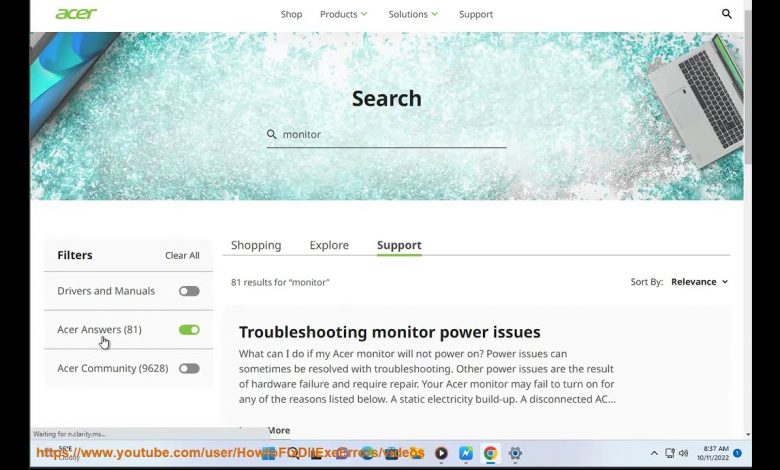Download & Install Drivers for Acer Monitor (2024 UPDATED)

Here’s how to Download & Install Drivers for Acer Monitor.
Here are the steps on how to MANUALLY download and install drivers for Acer monitors:
1. Go to the Acer Drivers & Manuals website.
2. Enter your device serial number, SNID, or model number.
3. Select the correct operating system for the driver you need.
4. Click Download, which will download a zip file containing the files you need.
5. Unzip the file by double-clicking it. This will extract the files you will need to update your driver (. INF) and color profile (. ICM).
6. Right-click the Start button, and in the Start menu, select Device Manager.
7. In the Device Manager, open the Monitors group, and select the monitor you want to install the driver for.
8. Right-click the monitor item, and in the popup menu, select Update driver.
9. In the Update Drivers window, select the option Browse my computer for drivers.
10. Click the Browse button, select the folder location of the monitor driver files, and then click Ok.
11. Click the Close button to finish the install.
Here are some additional tips for downloading and installing drivers for Acer monitors:
* Make sure that you are downloading the correct driver for your monitor. You can find the correct driver by checking the Acer Drivers & Manuals website or by contacting Acer customer support.
* If you are not sure how to install the driver, you can refer to the instructions that come with the driver file.
* If you are having problems installing the driver, you can try restarting your computer.
* If you are still having problems, you can contact Acer customer support for assistance.
i. There are a few reasons why your Acer monitor might not be detecting HDMI. Here are some troubleshooting steps you can take:
1. **Check the HDMI cable.** Make sure that the HDMI cable is properly plugged into both the monitor and the computer. You can also try using a different HDMI cable to see if that fixes the problem.
2. **Check the monitor’s input settings.** Make sure that the monitor is set to the correct input source. You can usually find this setting in the monitor’s menu.
3. **Restart your computer and monitor.** Sometimes, a simple restart can fix problems with HDMI detection.
4. **Update your graphics card drivers.** Outdated or corrupt graphics card drivers can cause problems with HDMI detection. You can update your graphics card drivers by going to the website of your graphics card manufacturer and downloading the latest drivers.
5. **Check your computer’s BIOS settings.** Make sure that your computer’s BIOS settings are set to enable HDMI output.
If you have tried all of these steps and your Acer monitor is still not detecting HDMI, you may need to contact Acer customer support for assistance.
Here are some additional troubleshooting tips that you can take if you are experiencing problems with your Acer monitor not detecting HDMI:
* **Try a different port on your computer.** If you are using a laptop, try using a different HDMI port on the laptop.
* **Try a different monitor.** If you have another monitor, try connecting it to your computer to see if that fixes the problem.
* **Try connecting your computer to a TV.** If you can connect your computer to a TV, this will help you to determine if the problem is with your monitor or with your computer.
ii. Here are some troubleshooting steps you can take if your Acer monitor is not showing 144Hz:
1. **Check the monitor’s specifications.** Make sure that your monitor is actually capable of displaying 144Hz. You can find this information in the monitor’s manual or on the Acer website.
2. **Check the monitor’s input settings.** Make sure that the monitor is set to the correct input source and that the input signal is set to 144Hz. You can usually find this setting in the monitor’s menu.
3. **Check your graphics card drivers.** Outdated or corrupt graphics card drivers can cause problems with 144Hz display. You can update your graphics card drivers by going to the website of your graphics card manufacturer and downloading the latest drivers.
4. **Use a DisplayPort cable.** HDMI cables typically don’t support 144Hz refresh rates. If you are using an HDMI cable, try using a DisplayPort cable instead.
5. **Restart your computer and monitor.** Sometimes, a simple restart can fix problems with 144Hz display.
If you have tried all of these steps and your Acer monitor is still not showing 144Hz, you may need to contact Acer customer support for assistance.
Here are some additional troubleshooting tips that you can take if you are experiencing problems with your Acer monitor not showing 144Hz:
* **Try a different port on your computer.** If you are using a laptop, try using a different DisplayPort port on the laptop.
* **Try a different monitor.** If you have another monitor, try connecting it to your computer to see if that fixes the problem.
* **Try connecting your computer to a TV.**
